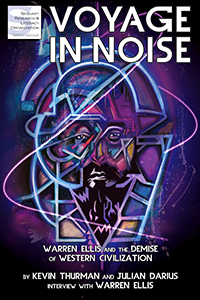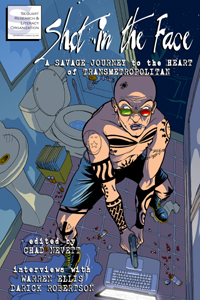At times, reading Warren Ellis’ and Ivan Rodriguez’ unfinished story Doktor Sleepless, especially in single issues, can feel like showing up a day late to the party of the century. The vibrant community surrounding the book that Ellis wrote about in the backmatter as well as Ellis himself seems to have moved on to other things. The discussion boards and wikis are either long gone or long dormant. The last issue to come out, issue thirteen, was published in 2009. Although incomplete, Doktor Sleepless reads like the ultimate Warren Ellis story (it’s also possible that its unfinished status adds to this feeling considering the number of projects he has left unfinished over the years.), which makes it one of the most important stories to read if you’re at all interested in Warren Ellis. This essay will focus on the first eight issues which were collected into trade. The remaining issues have yet to be collected since the story arc was never completed. The most compelling aspect of the story is its fusion of contradictions: the real and the simulacrum, the imagined future of the past and the present, fact and fiction, hard science fiction and Lovecraftian horror.
Doktor Sleepless tells the story of John Reinhardt, a one-time resident of the city of Heavenside whose return creates chaos in a city that was already on the edge. The very first words in issue #1, “Today I stop being real,” establish the theme of conflation that run throughout the story. The words are spoken by Reinhardt who on the first page of the story is in the process of taking on the identity of Doktor Sleepless, a mad scientist archetype because “people like listening to characters. Characters are safe, because they’re not real.” Additionally, Ellis says in The Captured Ghost Interviews that “The appeal of them (mad scientists) in fiction is that they will break all possible frontiers and boundaries without a thought for anyone else ’cause they just want the big idea”(67). Later in the story, it is revealed that there are actually two John Reinhardts currently in Heavenside with one of them having been imprisoned for the past three years. In issue #3, the John Reinhardt who has been locked in a metal institution tells the detective who locked him up a story about a woman named Alexandra David-Neel, a real person who was born in 1868 and died in 1969. The story that Reinhardt tells is about David-Neel’s creation of a tulpa, which is “a thought-form. A manifestation of intent in human form out of imagination.” The still-unanswered question then is which John Reinhardt is the simulacrum and which is the real? It is possible however, that the answer is not nearly as important as the ideas it inspires, and these ideas are explored at length in issue #5 during one of Doktor Sleepless’ nightly radio transmissions where he talks about authenticity with regard to musicians like Richey Manic (of the The Manic Street Preachers), Godspeed You! Black Emperor, Big Bill Broonzy, and Memphis Minnie. Reinhardt concludes that authenticity is meaningless,“We can be anyone we can imagine being. We can be someone new every day…Be mad scientists. Here at the end of the world it’s the only thing worth doing.”
Reinhardt’s nightly radio broadcasts are addressed to and followed intensely by the Grinders, transhuman residents of Heavenside who combine body modification with technology: DIY cyborgs. They exist largely because of Reinhardt who, before he left Heavenside scattered a lot of technology around in bars and clubs without instruction and let people do with it whatever they wanted. The result was the Grinder subculture. One interesting subset of the Grinders, and the one Ellis spends the most time with is the Shrieky Girls. The Shrieky Girls are all connected to each other wirelessly so that if one girl feels something, then all of them feel it as well. Reinhardt says,“Shrieky Girls are never alone. They live in an invisible web of constant secret conversation, transmitting raw feeling as if they were texting notes.” This technology appears to be an internalization of the Empathy Boxes of Mercerism from Do Androids Dream of Electric Sheep which is another important theme of Doktor Sleepless, the idea that the future is internal rather than external.
In issue #1, there is a sequence of panels that show some of the graffiti found in Heavenside, “Where’s my fucking jetpack?” “You owe me a flying car.” and “Not my future.” The graffiti reflects the feelings of the inhabitants who seem haunted by an imagined future. This is reminiscent of the real-life aesthetic known loosely as Hauntology which appears mostly in music (music seems to have had a strong influence on Doktor Sleepless considering how often references to music appear in the story and how Ellis often wrote in the backmatter pages what music he was listening to when he wrote the scripts), but can also be seen in art blogs like Scarfolk Council (http://scarfolk.blogspot.kr/). The basic idea of Hauntology is that the past always haunts the present, however in Doktor Sleepless Ellis tweaks the concept a bit with past visions of the future haunting the present, or rather haunting the psyches of the Grinders in Heavenside. Ellis ends the issue addressing this malaise, “The future sneaks up on us. It leaks in through small ordinary things…While you wait for the future you think you’re owed, you fuck around with your bodies like they were virtual-world avatars…You treat them like characters to be improved and you grind them.” Ellis says, quoting J.G. Ballard that “the future will be boring…because it’s really just more of the present.”(93-4) Views of the future, whether utopian or dystopian get in the way of understanding the world as it is, which is a tangle of the past, past visions of the future, and technology that no-one could ever see coming.
This world view that Ellis presents in Doktor Sleepless is also interwoven within the text itself in both the way that it conflates fact and fiction and in the way that the story is a blend of science fiction and Lovecraftian horror. At several points within the story, Ellis makes use of an
intentional blurring of the lines between fact and fiction. The most notable example is the story of Alexandra David-Neel who, as mentioned above was a real person who traveled all over the world and spent many years in Tibet learning about Buddhism at a time when it was almost unheard of for an outsider, much less a woman to do so. However, the story of her tulpa is fictional (or at least unverifiable) and exists in the story as a way to introduce the idea that there are currently two John Reinhardts in Heavenside. Another example appears in the backmatter of issue #4 with the history of the fictional groupblog website imminent.sea. Years before the events in Doktor Sleepless, John Reinhardt was a member of this groupblog whose goal was to “track outbreaks of the future.” One of the members of the group went by the name of Captain Swing was was an actual early (nineteenth century) instance of an open source identity that anyone, in particular anti-industrialization protesters and early anarchists could adopt as a means of getting their message out. Ellis would go on to use the Captain Swing name in the Avatar miniseries Captain Swing and the Electrical Pirates of Cindery Island with art by Raulo Caceres. While this interweaving of fact and fiction is certainly not new to comics, it’s been going on since practically the beginning, it is noteworthy that Ellis would take these very obscure elements from past counter cultures and radical thinkers and incorporate them into the story about the counter culture’s identity with regard to its relation to the future. One final example that will also lead to the final point is the blend of fact and fiction in the history behind the fictional book The Darkening Sky by Henrik Boemer.
The backmatter of issue #1 begins with a brief description of The Darkening Sky, it’s publication history, and a synopsis. Ellis describes it as “a new exploration of the philosophy of Fatalism” and a book that, very much like Doktor Sleepless, “combines treatise and fiction in its discussion of cyclical history and its notion that humanity can combine into a perpetual-reality ‘machine’ that can overthrow the tyranny of ‘time’ itself.” Ellis says of the book’s author Henrik Boemer that he was obsessed with the Elder Gods of H.P. Lovecraft and incorporated much of Lovecraft’s mythos into the The Darkening Sky. This too is a major aspect of the Doktor Sleepless storyline, which fuses near-future science fiction technology with treatises about culture and modern life and Lovecraftian horror. Indeed, Lovecraft’s Elder Gods seem to play a major role in John Reinhardt’s origin and since it is tied to Reinhardt’s origin: a young boy from a wealthy family who witnesses the death of his parents, but not by a robber or an exploding planet but by his parents opening a gateway to the elder gods and having their life force drained by tentacled monstrosities. This event sets Reinhardt on his path first as an explorer of the future as himself and later as the mad scientist character Doktor Sleepless who in his own way wants to, in typical mad scientist fashion, end the world. However, his reason for doing so is a massive act of revenge against the Elder Gods by depriving them of a food source.
With each year that passes, it becomes less and less likely that Ellis will ever return to Doktor Sleepless with all of its unanswered questions (for example, what are those mechanical angels?) and Heavenside teetering on the brink of destruction. There are always rumors that Ellis will return, and if so it would indeed be great to see him, preferably along with Ivan Rodriguez continue the story. If not though, it still doesn’t change the experience of reading those first eight issues. Doktor Sleepless is Planetary without the superpowers and excavations of the roots of 20th century superhero comics and Transmetropolitan without politics. It’s Ellis.
























































